La Machine Fleuve
The River Machine
performance for 20 music boxes, 1 bicycle and 2 performers - 2014Duration : 1:20 in concert version / several hours in performance version

LA MACHINE FLEUVE is a concert, it's also a performance, but it's not theater or dance, however it's sport, it is a bicycle, and it's chains, gears, pulley, belt, it is an amplified wall, it is 20 music boxes playing punched cards, it's written and interpreted but it is improvised, it is micro-intervals, sound pixels, held notes and it's vibrating beats, it's a cyclist and a punched cards manipulator, it's 80 minutes and it can be several hours in free access, it is 500 perforated cards of 65,000 holes, it is Franco-Russian, it's music.
La Machine Fleuve is born of my unexpected meeting of the Russian composer Boris Filanovsky in St. Petersburg in 2010. I was exhibiting Dropper01 as part of the France-Russia Year, he was (still is) the creator and artistic director of eNsemble, contemporary music ensemble in St Petersbourg. We wanted to work together and we did.
So after a few sessions of research in my workshop in Toulouse, we have outlined a project that offered everyone the freedom of art writing: a concert of music boxes driven by a bicycle ...
In July 2014, in residency at the Theatre Le Hangar, we created La Machine Fleuve. Boris composed music and made thousands of holes in cartons (about 65,000 holes in 500 cartons), while I built our lutherie for 20 music boxes and 1 bicycle, and was doing lighting and staging.
Lutherie and composition are closely linked, so the exchanges were constant and our works were fed each other.
As a composer, Boris said "a music box is a semantic trap. it is an instrument meant not for music as such, but for recollections of music, a toy making equal Ode to Joy and Ach mein lieber Augustin", an instrument full seductive sentimentalism. So, he has immediately measured the stiffness of the instrument: the repetition rate of the same note is limited by mechanical constraints and the size of the perforations, and there is no control of the volume nor of the attack (pianissimo / fortissimo), nor the sustain (duration of a note: no sound difference between an eighth and a black), or the release (how the sound decreases) ... in short it is a "non-instrument." But this is precisely the reason why he get involved with enthusiasm, because he "likes when the composition substance shows resistance" ...
By discovering that Arno was able to tune precisely the pitch of each of music box, Boris has found its solution. He realized that an ensemble of music boxes could be approached as a single instrument (rather than accumulation of instruments), and thus, he could neutralize the trap of those seductive sentimentalism music boxes and use the instrumental constraints. A remarkably elegant and pertinent solution, reflecting his intimate understanding of the instrument that Arno proposed to him.
The solution was to produce a river of notes (hence the title La Machine Fleuve / The River Machine) with 12 diatonic music boxes, each of which is tuned slightly differently (microtonal variations in 1/4 and 1/8 ton). This rapid repetition of notes almost similar allows us :
- Firstly, to move from a multitude of repeated notes (a kind of "pixel sound"), to a continuous note, quiet and slow, produced by intermixing of these noise pixels, a kind of mixed sound;
- Secondly, to access a sound wave produced by the simultaneous emission of two (or more) note slightly "detuned", a new sound, which seems mysterious, generated by the "friction" of frequencies very close but different.
Thus, Boris works on three levels of perception: the Sound pixel, note keeping and vibratory beat.
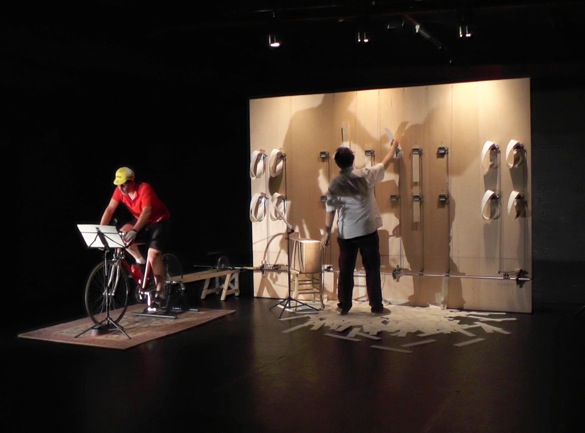
Description :
- on a resonant wall are fixed 8 chromatic music boxes (30 notes) and 12 diatonic music boxes (20 notes) ;
- the 12 diatonic music boxes are individually retuned by microtonal variations (1/4 and 1/8 tone), as directed by the composer ;
- the resonant wall is amplified, speakers on each side play the sound ;
- a bicycle plays the music boxes, with a set of pulleys, chains and sprockets ;
- punched cards pass through the music boxes and so they make the music. A card can be inserted into the normal way, reversed (start / end) or back (bass / treble). The cards can pass into several music boxes, and also, they can be played in a loop ;
- cards already used crammed on the floor.
Two versions are available:
- The concert, which lasts about 1:20;
- The performance of a variable period of several hours where the public can enter and exit at will, and can be envisaged outside.

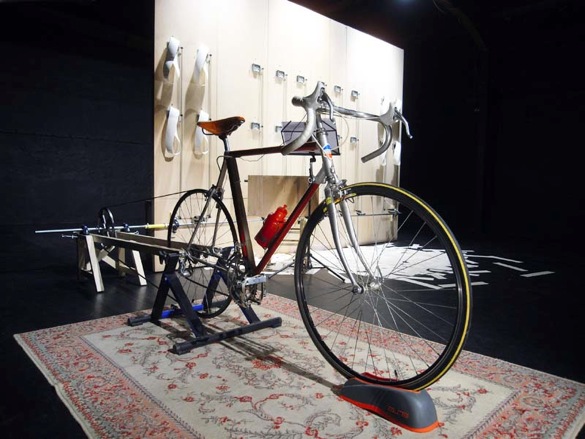
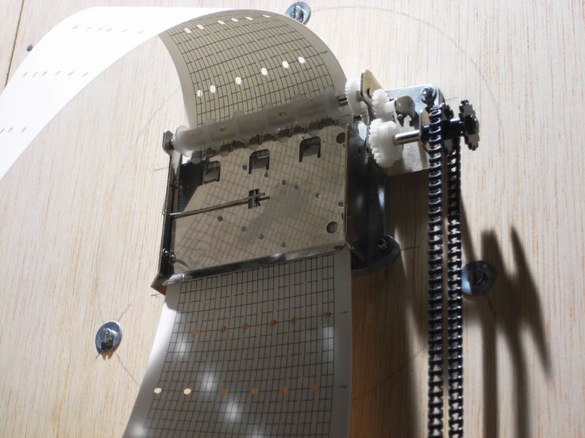
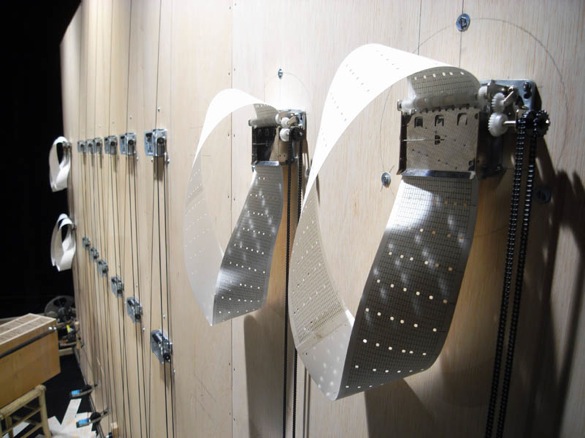


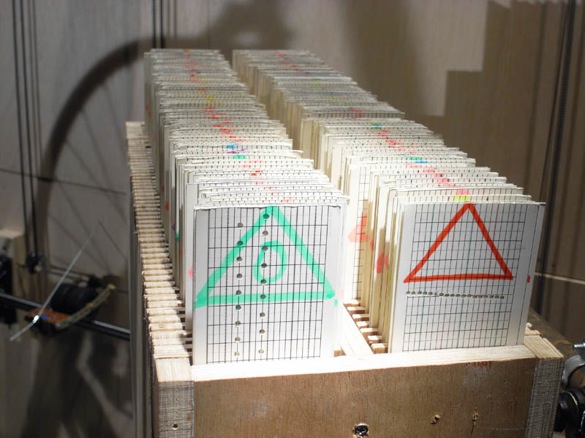
design, staging et interpretation (cyclist) > Arno Fabre
composition and interpretation (carton's manipulator) > Boris Filanovsky
production manager > Fabienne Lagrange
production and diffusion > c15d
La Machine Fleuve is supported by Ville de Toulouse, Région Midi-Pyrénées and by Théâtre Le Hangar.


